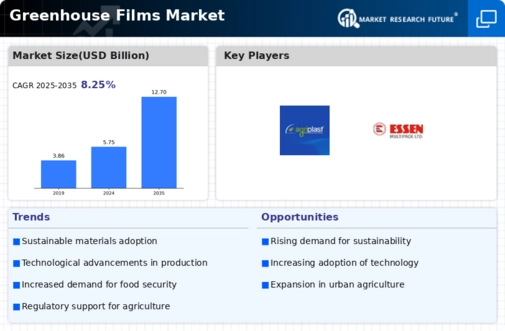Top Industry Leaders in the Greenhouse Film Market

The greenhouse film market is poised for continued growth, driven by the aforementioned factors and the constant innovation in film technology. Sustainability, resource efficiency, and precision agriculture will be key trends shaping the future landscape. As competition intensifies, players who adapt to these trends and offer unique value propositions will be the ones to reap the rewards in this fertile field.
Market Strategies: Cultivating Success
-
Product Innovation: Leading players like Svensson, Plastics Manufacturing Company, and Ginegar are pouring resources into R&D, developing films with enhanced light diffusion, temperature control, and anti-microbial properties. Sustainable innovations like biodegradable films made from recycled materials are also gaining traction. -
Geographical Expansion: Established players are targeting emerging markets like India, China, and Latin America, where greenhouse cultivation is burgeoning. Local partnerships and acquisitions are common strategies to navigate regulatory hurdles and build brand recognition. -
Vertical Integration: Several players are consolidating their supply chains by acquiring raw material suppliers and distributors. This gives them greater control over quality, cost, and market responsiveness. -
Distribution and Customer Service: Building strong relationships with growers and offering comprehensive technical support is crucial. Online platforms and mobile apps for film selection and crop-specific recommendations are increasingly popular. -
Sustainability Focus: Growing environmental concerns are pushing companies to adopt sustainable practices. Offering recyclable films, reducing energy consumption in production, and minimizing waste are becoming differentiating factors.
Market Share Drivers: Seeds of Success
Several factors influence a company's position in the competitive landscape:
-
Film Type and Quality: Producing films tailored to specific crops and regions, with features like UV protection and diffusing properties, attracts loyal customers. -
Price and Cost-Effectiveness: Balancing affordability with product quality is crucial, especially in price-sensitive markets. -
Brand Reputation and Trust: A strong track record of delivering reliable films and excellent customer service builds trust and market share. -
Distribution Network and Reach: Extensive distribution networks and partnerships with key players in the greenhouse industry ensure wider market penetration. -
Government Policies and Regulations: Government subsidies and support for greenhouse technologies influence demand and market dynamics.
Key Companies in the Greenhouse Films market include
- Ginegar Plastic Products Ltd. (Israel)
- Lumite Inc. (U.S.)
- RPC Group plc (U.K.)
- Agriplast (Italy)
- Agriplast Tech India Pvt. Ltd. (India)
- Essen Multipack (India)
- Beijing Kingpeng International Hi-
- Central Worldwide Co. Ltd. (Thailand)
- Vis and Son Company Limited (Thailand)
- Thai Charoen Thong Karntor Co.Ltd. (Thailand)
- Tuflex
Industry News
July 2023: Berry Global acquires RPC Group, a leading European manufacturer of agricultural films, strengthening its presence in the European market.
August 2023: Naftan unveils a new range of biodegradable greenhouse films made from plant-based materials, catering to the growing demand for sustainable solutions.
September 2023: The International Society for Horticultural Science hosts a conference on greenhouse technology, highlighting advancements in film materials and optimization techniques.
Global availability of DuPontTM FilmTecTM FortilifeTM NF1000 membrane elements will happen in November 2023. These nanofiltration elements are more productive and can be used to recycle water in some difficult areas at lesser energy consumption than the previous versions.
November 2023- Chemours has expanded its HFC-152a capacity, ensuring a domestic supply of low global warming potential solutions.
Gotham Greens, one of New York’s largest fresh food and urban agriculture companies, opened its second high-tech hydroponic greenhouse in Colorado in August 2023. This new opening boosted manufacturing capacity more than fivefold in the Rocky Mountain region.

